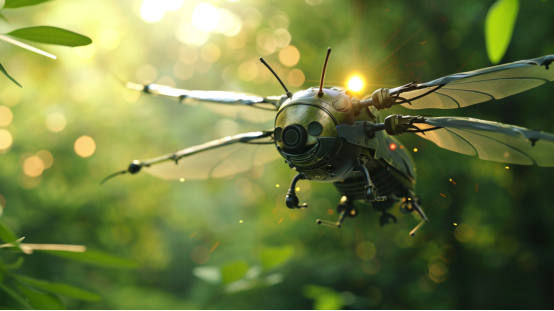模仿昆虫大脑:高效机器人技术的飞跃
原文链接:https://www.unite.ai/mimicking-insect-brains-a-leap-forward-in-efficient-robotics/

In the vast expanse of nature, some of the most profound inspirations come from the smallest of creatures. Insects, often overlooked due to their diminutive size, are in fact marvels of navigation and efficiency. Their ability to maneuver through complex environments with a brain no larger than a pinhead has long intrigued scientists and engineers alike. Leading the charge in uncovering these secrets is physicist Elisabetta Chicca, whose recent work bridges the gap between biological understanding and technological innovation.
在浩瀚的大自然中,一些最深刻的灵感来自最小的生物。昆虫由于体积小而经常被忽视,事实上它们是导航和效率的奇迹。长期以来,科学家和工程师们都很感兴趣,因为它们的大脑不比针头大,能够在复杂的环境中机动。物理学家Elisabetta Chicca率先揭开了这些秘密,她最近的工作弥合了生物学理解和技术创新之间的差距。
Chicca has embarked on a journey to decode how these tiny creatures achieve such remarkable feats. Her work not only sheds light on the mysteries of insect navigation but also paves the way for advancements in energy-efficient computing and robotics.
Chicca已经开始了一段旅程,来破解这些微小的生物是如何取得如此非凡的成就的。她的工作不仅揭示了昆虫导航的奥秘,也为节能计算和机器人技术的进步铺平了道路。
Unlocking Insect Navigation
解锁昆虫导航
Insects, despite their limited neural resources, exhibit astonishing navigational skills. They effortlessly avoid obstacles and adeptly move through the tiniest of openings, a feat that has puzzled scientists for years. The crux of this ability lies in their unique perception of the world.
昆虫,尽管它们的神经资源有限,却表现出惊人的导航技能。它们毫不费力地避开障碍,熟练地穿过最微小的开口,这一壮举多年来一直困扰着科学家。这种能力的关键在于他们对世界的独特感知。
Chicca explains in her research that a key aspect of insect navigation is how they perceive motion. It’s akin to the experience of sitting on a train and observing the landscape: trees close by seem to move faster than distant houses. Insects use this differential speed of movement to gauge distance and navigate. This simple yet effective method works well when moving in a straight line. However, the real world is seldom that straightforward.
Chicca在她的研究中解释说,昆虫导航的一个关键方面是它们如何感知运动。这就像坐在火车上观察风景一样:近处的树木似乎比远处的房屋移动得更快。昆虫利用这种不同的移动速度来测量距离和导航。这个简单而有效的方法在直线运动时效果很好。然而,现实世界很少如此简单明了。
Insects adapt to the complexities of their environment by simplifying their behavior. They typically fly in a straight line, make a turn, and then proceed in another straight line. Chicca’s observations reveal an important lesson: limitations in resources can be counterbalanced by behavioral adjustments.
昆虫通过简化行为来适应环境的复杂性。它们通常沿着一条直线飞行,转弯,然后沿着另一条直线前进。奇卡的观察揭示了一个重要的教训:资源的限制可以通过行为调整来抵消。
The journey from biological insights to robotic applications is a tale of interdisciplinary collaboration. Thorben Schoepe, a PhD student under Chicca’s supervision, developed a model mimicking the neuronal activity of insects, which was then translated into a small, navigating robot.
从生物学见解到机器人应用的旅程是一个跨学科合作的故事。在奇卡的监督下,博士生Thorben Schoepe开发了一个模仿昆虫神经元活动的模型,然后将其转化为一个小型导航机器人。
This robot, embodying the principles of insect navigation, was a product of close collaboration with Martin Egelhaaf, a renowned neurobiologist from Bielefeld University. Egelhaaf's expertise in understanding the computational principles of insects was crucial in developing a model that accurately emulated their navigational strategies.
该机器人体现了昆虫导航的原理,是与比勒费尔德大学著名神经生物学家Martin Egelhaaf密切合作的产物。Egelhaaf在理解昆虫计算原理方面的专业知识对于开发准确模拟昆虫导航策略的模型至关重要。
The Robot's Navigational Feats
机器人的导航特性
The true testament to any scientific model lies in its practical application. In the case of Chicca's research, the robotic counterpart of an insect's brain showcased its capabilities in a series of complex tests. The most striking of these was the robot's navigation through a corridor, its walls adorned with a random print. This setup, designed to mimic the varying visual stimuli an insect encounters, was a challenging course for any navigation system.
任何科学模型的真正证明都在于它的实际应用。在奇卡的研究中,昆虫大脑的机器人在一系列复杂的测试中展示了它的能力。其中最引人注目的是机器人在走廊中的导航,走廊的墙壁上装饰着随机的图案。这种设置旨在模仿昆虫遇到的各种视觉刺激,对任何导航系统来说都是一个具有挑战性的过程。
The robot, equipped with Thorben Schoepe's model, demonstrated an uncanny ability to maintain a central path in the corridor, a behavior remarkably similar to that of insects. This was achieved by steering towards areas with the least apparent motion, mimicking the insect's natural strategy to gauge distance and direction. The robot's success in this environment was a compelling validation of the model.
该机器人配备了Thorben Schoepe的模型,展示了在走廊中保持中心路径的神奇能力,这种行为与昆虫的行为非常相似。这是通过模仿昆虫测量距离和方向的自然策略,转向运动最不明显的区域来实现的。机器人在这种环境中的成功是对模型的有力验证。
Beyond the corridor, the robot was tested in various virtual environments, each presenting its own set of challenges. Whether it was navigating around obstacles or finding its way through small openings, the robot displayed an adaptability and efficiency reminiscent of its biological counterparts. Chicca concluded that the model's ability to perform consistently across different settings was not just a demonstration of technical prowess, but a reflection of the underlying efficiency and versatility of insect navigation.
在走廊之外,机器人在各种虚拟环境中进行了测试,每种环境都有自己的挑战。无论是在障碍物周围导航,还是在小开口中寻找出路,机器人都表现出了让人想起其生物同行的适应性和效率。奇卡得出的结论是,该模型在不同环境中保持一致的能力不仅是技术实力的证明,也是昆虫导航潜在效率和多功能性的反映。

Thorben Schoepe's robot in a corridor with random print. Photo Leoni von Ristok
Thorben Schoepe的机器人在走廊上随机打印。莱昂尼·冯·里斯托克照片
Efficiency in Robotics: A New Paradigm
机器人效率:一种新的范式
The world of robotics has long been dominated by systems that learn and adapt through extensive programming and data processing. This approach, while effective, often requires substantial computational resources and energy. Chicca's research introduces a paradigm shift, drawing inspiration from the natural world where efficiency is key.
长期以来,机器人世界一直由通过广泛的编程和数据处理来学习和适应的系统所主导。这种方法虽然有效,但往往需要大量的计算资源和能量。奇卡的研究引入了范式转变,从效率至关重要的自然世界中汲取灵感。
Insects, as Chicca points out, are born with an innate ability to navigate efficiently from the get-go, without the need for learning or extensive programming. This ‘hardwired' efficiency stands in stark contrast to the traditional approach in robotics. By emulating these biological principles, robots can achieve a level of efficiency that is currently unattainable with conventional methods.
正如奇卡所指出的,昆虫天生具有从一开始就高效导航的能力,无需学习或广泛编程。这种“硬连接”的效率与机器人的传统方法形成了鲜明对比。通过模拟这些生物学原理,机器人可以达到目前传统方法无法达到的效率水平。
Chicca envisions a future where robotics is not just about learning and adaptation, but also about innate efficiency. This approach could lead to the development of robots that are smaller, use less energy, and are more suited to a variety of environments. It's a perspective that challenges the status quo and opens up new possibilities in the design and application of robotic systems.
奇卡设想了一个未来,机器人不仅仅是学习和适应,还有天生的效率。这种方法可以开发更小、能耗更低、更适合各种环境的机器人。这是一个挑战现状的视角,为机器人系统的设计和应用开辟了新的可能性。
智能佳机器人
400 099 1872




 浙公网安备 33010602011771号
浙公网安备 33010602011771号